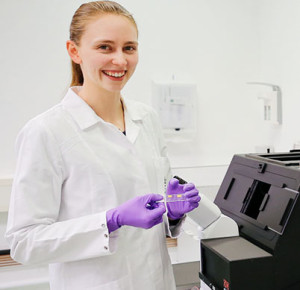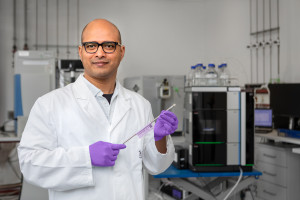Dortmund, 20th February 2024
During the SARS-CoV-2 pandemic, effective and safe vaccines quickly became available for large-scale vaccination programmes against COVID-19 – at least in wealthy industrialised countries. This development was possible only through significant effort and deployment of considerable financial resources on research, production and distribution. With a view to future endemics or pandemics, it would be desirable to also have inexpensive and effective antiviral active agents available worldwide as a prophylaxis and treatment – especially at an early stage of the outbreak.
Natural medicine has known several prophylactic, alleviating or even healing substances, mainly natural substances, for time immemorial. In the case of respiratory infection, for example, people have used infusions for millennia as a home remedy and self-medication or to alleviate symptoms. In Europe, for instance, sage is valued as a plant for medicinal and herb infusions (see info box) to combat bacterial colds and respiratory illnesses. Perilla and its variants are popular and widespread primarily in Asia. The antimicrobial effect of extracts from both plants has been described. But what about viral infections? Can infusions from sage (Salvia officinalis) or perilla (Perilla frutescens) be used – whether as a prevention or an aid to healing – against coronavirus infections? These questions were investigated by an interdisciplinary team headed by Prof Dr Mirko Trilling from the Faculty of Medicine at the University of Duisburg-Essen (UDE) and researchers at ISAS during the coronavirus pandemic.
PLANT INFUSIONS
For respiratory illnesses, such as bronchitis or pneumonia, traditional medicine uses a range of plants with healing properties. These include many representatives of the Lamiaceae (labiate) family. Many culinary and seasoning herbs with a high essential oil content belong to this plant genus: basil, lavender, marjoram, (pepper)mint, oregano, rosemary and thyme. The team of researchers headed by Prof Dr Mirko Trilling established antiviral activity not only in perilla and sage but also in infusions from two other labiates such as thyme and mint. The latter two contain a high concentration of caffeic acid. Even infusions made from conventional peppermint teabags demonstrated this effect.
Inhibition of all tested variants of SARS-CoV-2?
“I knew from my mother-in-law that an infusion of perilla leaves is drunk in Vietnam as a tea to combat colds,” says the virologist, recalling the background to the analyses. He goes on: “Even before the COVID-19 pandemic, we investigated whether such an infusion is effective against herpes simplex viruses. But it did not show any effect against human herpesvirus type 1.” Upon the outbreak of the pandemic, Dr Vu Thuy Khanh Le-Trilling, first author of the study, turned to this topic again. To the researchers’ great surprise, it turned out that perilla and sage infusions are effective against SARS-CoV-2 in cell cultures even at high dilutions. The active agents are therefore capable of protecting human cells from infection. This was interpreted as meaning that heat-stable compounds in a cocktail of substances had to be involved. As became apparent over the course of further analyses, inhibition of viral replication was in no way restricted to one variant of SARS-CoV-2.

Prof Dr Mirko Trilling is a virologist and holds a professorship at the Faculty of Medicine at the University of Duisburg-Essen. Together with his team, he conducts research at the Institute of Virology at the University Hospital Essen. His research focuses on antiviral mechanisms and the strategies that viruses use to evade them.
© UDE/ Frank Preuß
Caffeic acid, perilla aldehyde and perilla alcohol
“Our tests with measurements before and after an infection with SARS-CoV-2 were performed in cell cultures. For this purpose, we used both a human cell line and cells from the vervet monkey,” explains Trilling. The cells were pretreated with samples of the infusions for various periods of time, then infected with the new coronavirus and further incubated at different times in turn. In order to detect the antiviral active agents in the plant infusions, the researchers first applied themselves to sorting the biomolecules present in the infusions by size. They then fractionated them and tested whether the fractions inhibited viral replication.
In the fraction with a molecular mass of under 1,000 daltons, the researchers made a discovery. They finally succeeded in identifying three antiviral compounds in the plant infusions: caffeic acid, perilla aldehyde and perilla alcohol. The combination of the three substances increased the antiviral effect against SARS-CoV-2 even more. This was a synergistic effect, as demonstrated by further experiments. Plant infusions based on both perilla and sage demonstrated in vitro an antiviral effect against the coronavirus variants Alpha, Beta, Delta and Omicron. Under the chosen laboratory conditions, these antiviral effects were comparable or even superior to those of interferon beta and the drug Veklury® (remdesivir) (see info box) used in certain cases of COVID-19.
ACTIVE AGENT REMDESIVIR
The drug Veklury® is a virostatic agent, which means the active agent remdesivir that it contains inhibits the reproduction of viruses such as the Ebolavirus, SARS-CoV-2 and more. The medication has had a conditional approval in Europe for the treatment of COVID-19 since July 2020. Medical professionals may use the drug in adults and young people (minimum weight 40 kilograms) with COVID-19 and pneumonia (inflammation of the lungs) who require additional oxygen but not invasive ventilation.
Target molecule discovered for new antiviral therapeutic options
In order to assess whether and how the population of proteins in the cells changes with and without the addition of the infusion, as well as before and after the infection with SARS-CoV-2, a comprehensive mass spectrometry examination was the method of choice. The analysis of the proteome (entire set of proteins in the cell being examined) this makes possible was performed by researchers at ISAS. The point of determining the amounts of protein involved was to clarify the effect of plant extracts on the proteome of the cells. A comparative analysis of the MS findings eventually led the researchers to the protein heme oxygenase (HMOX-1). HMOX-1 is an enzyme that is involved in the cellular response to oxidative stress.
Le-Trilling, V. T. K., Mennerich, D., Schuler, C., Sakson, R., Lill, J. K., Kasarla, S. S., Kopczynski, D., Loroch, S., Flores-Martinez, Y., Katschinski, B., Wohlgemuth, K., Gunzer, M., Meyer, F., Phapale, P., Dittmer, U., Sickmann, A., & Trilling, M.
(2022). Identification of herbal teas and their compounds eliciting antiviral activity against SARS-CoV-2 in vitro. BMC Biology, 20(1), 264. https://doi.org/10.1186/s12915-022-01468-z.
The concentration and activity of HMOX-1 ultimately increased in infected cells that had been cultivated with perilla or sage infusions. “But this was initially only a correlation that we saw,” explains Trilling. The researchers managed to provide evidence of the effectiveness of HMOX-1 by using sulforaphane and fraxetin, substances that induce HMOX-1. Both are known to increase the quantity of HMOX-1 and also demonstrated an antiviral effect. Now combining suboptimal doses of fraxetin with perilla or sage in an infection experiment gives rise to a strong antiviral effect. The findings gained finally make clear that the protein HMOX-1 is mainly responsible for this – and is thus considered to be a mediator of the antiviral effect of the two plant infusions. With the results of their analyses, the researchers from Essen and Dortmund have discovered a new molecular target for future antiviral therapeutic options.
(Dr Thomas Krämer)








